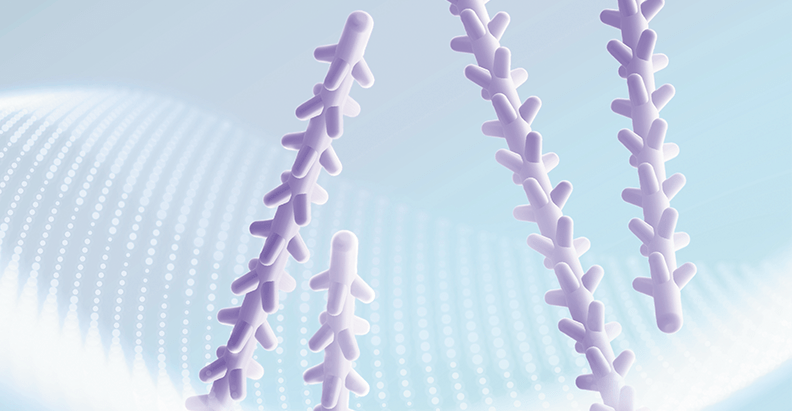Jean-Paul Foumentèze describes a simple technique that gives similar results to that of a face-lift
The current consensus is clear; suspension threads are deemed efficient, only moderately, when used on faces and necks showing little ptosis, with the results lasting only a few months. The present article aims to show how, by using high-quality permanent threads and the adapted insertion technique, the effectiveness and durability of a traditional face-lift may be obtained for a patient (Figures 1–2).
Before I present and detail my preferred technique, the ‘parallel technique’, it must be understood that the technique is carried out using a high-quality, cogged, permanent suspension thread.
The technique must be imparted only after serious training, showing both the theoretical and practical aspects of the procedure. For too long now, the suspension thread technique has been considered a ‘lowly’ technique with no real results or finesse1, a technique requiring only a few hours of training by video, demonstration or even teleconferencing. In the minds of both physicians and patients, dubious marketing terms, such as ‘lunch-time lifts’ have given rise to the negative reputation of suspension thread techniques. On the contrary, it is necessary to overcome simplification if we are to achieve improved results. This procedure must be carried out with the same rigour as any other medical procedure.
A craftsman is nothing without the right tools
This technique must be carried out using high-quality, cogged, permanent suspension threads. If a similar result to that of surgical intervention is to be obtained, specific thread characteristics must be present.
A good thread must firstly and foremostly have a significant hooking ability. Be it made up of cones or cogs, they must be sufficient in number and closely spaced to allow for precise and efficient adjustment. The thread I use has innovative cogs, which are conical rather than cylindrical; that is to say, the base of the cog is larger than the tip thus giving it a better hooking ability and avoiding any reversal under strain.
The round tip neither injures the patient or causes any pain.

Figure 1 Photos taken (A) before and (B) two years after a face-lift procedure by Dr. Jean-Paul Foumentèze using permanent suspension threads on a patient aged 45 years. The patient underwent no further procedures and no filler injections
Laboratory tests have shown that this type of cog (made of solid medical-grade silicone) can only turn back when strain applied on the cog exceeds 15 Newtons (1.53kgs)2. This is 20% more than results for cylindrical-shaped cogs of the same material.
One thread has 800 cogs in all with a series of 4 moulded cogs every 1.5mm. Also, each 4-cog series is turned 45° compared with the preceding series, meaning tissue is hooked on eight axes rather than four (Figures 3–4).
It is equally important that the thread be able to resist a great deal of tension; otherwise, the results can be disappointing. The thread I use resists tension up to 22 Newtons (2.24kgs)3.
The thread should be flexible to follow facial movements but should not stretch over time. Just a 1 cm elongation of a classic 30cm thread (3.3%) would negate the procedure’s result, particularly in the oval and nasolabial groove region. Unfortunately, in my experience, this is the pitfall when using threads with elastic structures or materials. Over time, elasticity wears out and the thread increases in length.
If we want an alternative to a surgical face-lift, then we need long-lasting results using threads made from equally long-lasting materials. Far from accepted ideas, I prefer to use a permanent thread that causes limited fibrosis since it creates only a small amount of cicatricial collagen4, does not necessitate the patient undergoing repeated procedures, while maintaining the possibility of easily being removed without any after-effects even after several years. This means the patient undergoes an efficient, long-lasting procedure, which does not have to be a lifetime commitment. Indeed, this is what a patient seeks when turning away from traditional surgical procedures, preferring a less invasive and traumatising technique.
Effectiveness has never really been a problem
For many years now, we have had the means to obtain very effective short or medium-term results using suspension threads5.
The first steps towards creating an effective face-lift came about more than ten years ago when threads were lengthened to include more cogs; the more cogs there are, the more the physician can lift the facial tissue. All threads available today, be they absorbable or permanent, are of adequate length.
Further progress was made by inserting the threads higher, that is 1 to 2 cm above and in front of the upper part of the ear. Sometimes, the entry point of the thread is wrongly sited at the preauricular level to avoid the patient’s hair. Inserted at the preauricular level, the thread will undoubtedly leave a crease between eye and ear if the tension is significant. Consequently, the physician will limit thread tension, and the result will be disappointing. The correct point of insertion is the same as that of the temporal scar in a surgical face-lift.
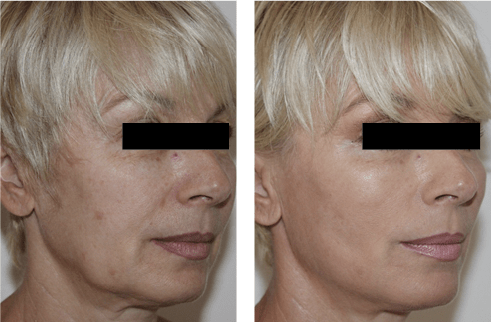
Figure 2 Photos taken (A) before and (B) one year after a face-lift procedure by Dr. Jean-Paul Foumentèze using permanent suspension threads on a patient aged 58 years. The patient underwent no further procedures and no filler injections
The third milestone was when consensus concerning the depth of insertion was reached. If too near to the surface, that is, too close to the dermis, the threads would create fossulae or creases when pulled. If inserted too deeply, they will lose their effectiveness. For the jugal and malar zones, it is essential that the threads be inserted in the hypodermis, while for the temporal area, they should be inserted close to the SMAS in order that the result is effective and the threads hidden.
Sustainability: the foe of effectiveness
Unfortunately, effect-iveness is not a synonym of sustain-ability. This has been an issue, without any solution, for a number of years; it was said by many that threads gave a rejuvenated look only for a limited period before the patient underwent a surgical face-lift.
However, by lengthening the thread and increasing the number of cogs or cones, greater tension can be acquired. At the same time, the more tension the thread undergoes, the more strain it suffers and the more it will tend to unhook rapidly. A solution, therefore, had to be found.
A complex process
Several solutions were put forward over the years. They all meant that the insertion techniques became more complex.
One solution was to insert threads using an X-shaped pattern, the aim being to make a turn around a solid area, such as connective or muscular fibres. Unfortunately, all results using this technique were lost within one or two years, due probably to the lengthening of the fibres used as anchoring points.
Another solution was to secure the threads on either side of the face to avoid eventual sagging, thus maintaining their effectiveness (Figure 5). One such technique is the Infinite-Lift technique.
The cogged suspension threads on either side of the face (shown in yellow and blue on the diagram) were secured on the dome of the head. As can be seen in the diagram, in purple, these suspension threads were joined with two loops beneath the scalp. The loops were made with the same cogged suspension threads, the cogs facing downwards, of course. The two loops served as an arch, guaranteeing the durability of the results over time.
The Infinite-Lift technique gave excellent sustainability results. The technique was complex but gave weight to the use of permanent suspension threads. So, why was the technique abandoned?
A simplified process to disseminate permanent suspension threads
Firstly, the Infinite-Lift technique used the older generation of suspension threads, whose cogs were unable to maintain their own weight and so dropped through the effect of gravity.
Also, because nowadays, a patient expects post-operative recovery to be lighter, shorter, and totally discreet. It was, therefore, necessary to offer a solution that took in these expectations at the risk of the patient not agreeing to the procedure despite the promise of a quality result.
Finally, because physicians, and more particularly surgeons, do not want to undergo a long training period for the technique. Neither is it desirable that the technique be as complex as that of a classic surgical face-lift. If it were, then it is easy to understand that a physician continues to operate a technique he knows perfectly, is used to presenting to prospective patients, and is certain of the quality of its results.
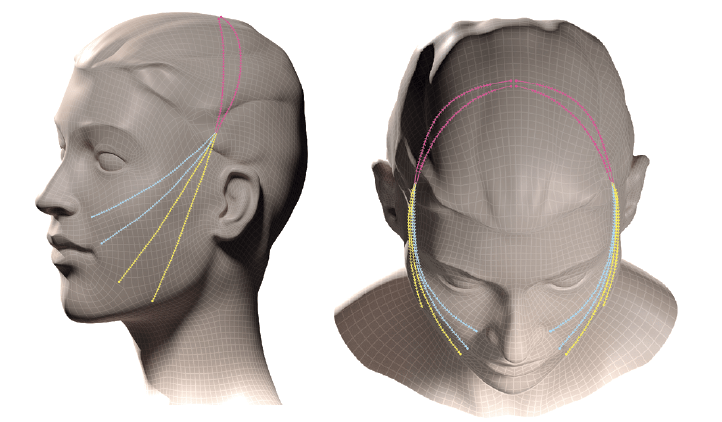
Figure 5 Profile and aerial view diagram of the infinite-Lift insertion technique
There was a possibility with the Infinite-Lift technique that a recurrent sensitivity at temporal level could occur where the cheek threads and scalp threads met. A thickness of threads at this temporal meeting point, which is shallow, was felt by some patients. The threads could also be felt if finger pressure was applied to the area. Moreover, a large but temporary bruise could appear in the eye area, again because of the recurrent passage of the insertion needle in this shallow area. Finally, the technique
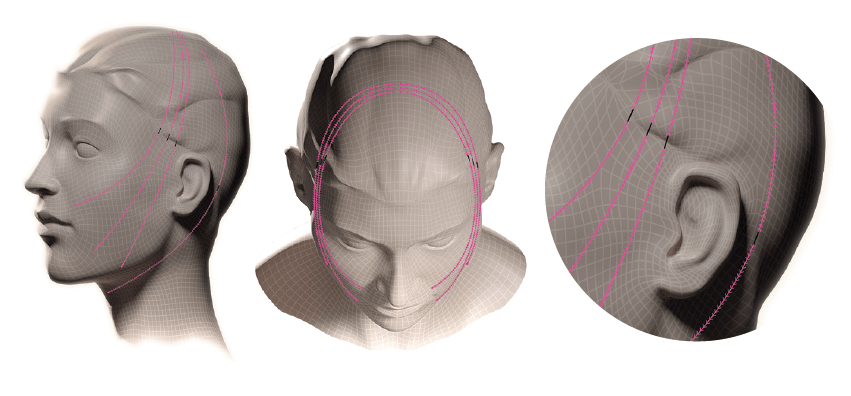
Figure 6 Profile, aerial and close-up diagram of Parallel insertion technique
needed the help of an assistant, notably for the threads exiting at the loop in the scalp, and this could increase procedure time to 90 minutes for a newly-trained physician.
Therefore, this albeit efficient technique needed to be improved to meet the expectations of the patient concerning post-operative recovery and discretion as well as the physician’s desire for simplification.
The level of maturity currently reached by cogged permanent suspension threads allows this salvific simplification through what is known as the Parallel technique. However, one should not confuse the desire to simplify the insertion technique with scientifically erroneous oversimplification and marketing considerations.
The Parallel technique
The Parallel technique uses three threads per side of the face (six in all) and also one thread per side of the neck (two in all) (Figure 6).
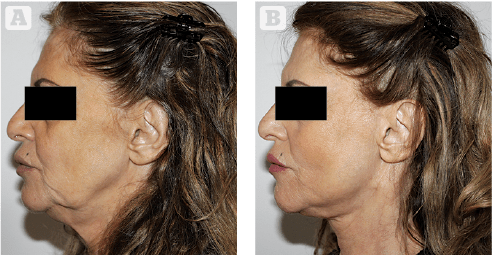
Figure 7 Photos taken (A) before and (B) a few months after a face-lift and neck-lift procedure by Dr. Jean-Paul Foumentèze using permanent suspension threads and the Parallel technique. The patient underwent no further procedures and no filler injections
The point of entry for the face threads is always at temporal level (the black marking of the thread) to ensure greater thread tension without creating any folds or furrows and to enable treatment of the upper third of the face.
This technique should be carried out using a suspension thread with bidirectional cogs.
Half of each of the three threads is inserted at the temporal point of entry, towards the dome of the skull, beneath the scalp and is cut flush at the exit point with no sutures required. At the temporal level, the threads are inserted deeply, contiguous to the SMAS. Each thread has its individual entry and exit point. These half threads, lying beneath the scalp, their cogs pointing downwards, will avoid sagging through the effect of gravity.
I have chosen to exit the threads as high as possible in order to have as long a cogged length as I am able to, but the temporal level remains the best hooking area.
The second half of each of the three threads is inserted towards the base of the face following the route decided on by the physician, after consultation with their patient, and according to the appropriate vectors. Figure 6 shows a standard route. The extremities here are also cut flush and require no suturing. The threads must be placed in the centre of the hypodermis so as to be efficient, and the threads are hidden. With the cogs pointing upwards, the physician can then pull up the sagging facial tissues using this second half of the threads.
If the neck is to be treated, a fourth thread is used; its point of entry is situated at the mastoid level.
Because it does not require surgery, the Parallel technique is called a ‘medical’ technique. The technique does not use a scalpel but blunt-ended needles; there is no visible scarring and no peeling of facial tissue.
I use a 19 cm needle, blunt at one end, an eye at the other end to thread the suspension thread.
Parallel technique: results
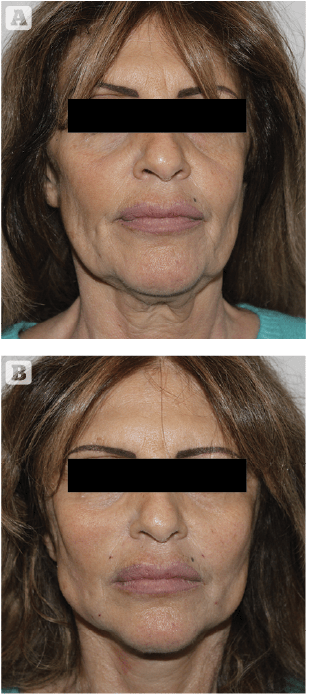
Figure 8 Photos taken
(A) before and (B) 15 minutes after a face-lift and neck-lift procedure by Dr. Jean-Paul Foumentèze using permanent suspension threads and the Parallel technique. The patient underwent no further procedures and no filler injections
Carried out with the appropriate permanent suspension thread, the Parallel technique offers patients results comparable to those of a mid-face-lift and neck-lift (Figure 7), thus satisfying both patient and physician.
The Parallel technique allows for:
- A natural look by repositioning sagging tissue to its original area, following the previously-marked contours
- A sustainable result thanks to the upper end of the thread that has 400 cogs oriented to stop the thread from slipping. The faces of patients I treated in 2016 with this combination of thread and technique have not undergone any change in 3 years
- Facility for the physician to master the technique with no need for an assistant. The procedure is carried out in less than one hour following a local anaesthetic
- Discretion thanks to hidden and painless threads. Rapid resumption of social activity (between 3 and 8 days) since there is no ecchymosis or bruising. There might be the appearance of slight oedema immediately after the procedure, 80% of which will disappear in the first week (Figure 8)
- Immediate quality of life for the patient. The slight post-operative discomfort can be treated with pain killers for a couple of days. Nothing is off-limits (e.g. any sleeping position, all sports — except extreme sports for just 1 week — no ban on saunas or sun-bathing)
- Total peace of mind since the threads may be retrieved through the temporal point of entry without any problems even years after their insertion.
And finally, as well as the advantages brought about by the Parallel technique described above, compared with older techniques, a youthful eye appearance returns thanks to the anterior thread route followed.
All procedures have their limitations
Permanent suspension thread lifts have three limitations. The first is the location of the lift. In my experience, only the face and neck are candidates for suspension thread lifts. This might change eventually, but for the moment I know neither thread nor technique for treating body lifts.
The second limitation concerns the patient’s skin, where sagging is too great. When skin resection greater than 1 cm is assessed, a surgical lift is indicated.
The third limitation concerns wrinkles, either too many or too deep. Before the suspension thread procedure can be undertaken, it will be necessary to have chemical peeling or laser resurfacing completed first.
Finally, and contrary to what is written elsewhere, ageing of the face post thread insertion, is neither a limitation nor a problem. No, the face will not age in such a way as to have to remove the threads. This is utter, unfounded nonsense. Gravity pulls on fatty areas year after year, and the marked contours remain the same. On the contrary, once held up by the cogs on the suspension threads, the said area will be less sensitive to the later effect of gravity. Years later, it might be necessary to add a thread to an area that presented no sagging at the time, but it will certainly not be necessary to wantonly remove the existing threads.
Declaration of interest None
Figures 1-8 © Jean-Paul Foumentèze
References:
- Gülbitti, Haydar Aslan et al. “Thread-Lift Sutures: Still in the Lift? A Systematic Review of the Literature.” Plastic and reconstructive surgery 141 3 (2018): 341e-347e .
- Resistance of the notch. Numerical simulation test. Document number 030_02_1719 carried out by the company Cisteo MEDICAL the 11/01/2018
- Tensile strength test on steamed and sterilized textile thread. Document number 030_02_1707 carried out by the company Cisteo MEDICAL the 01/06/2017
- Test for local effect and systemic toxicity after implantation in the subcutaneous tissues in the rat – 3 months. Report IMP-Toxsys-3months-PH17/0085 Phycher Bio Développement 2017
- B. Cornette de Saint Cyr, L. Benouaiche “ Face rejuvenation with tensor threads.” Annales de chirurgie plastique esthétique (2017) 62, 488—494

